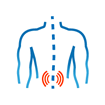Your shopping cart is empty!
EMS machine Australia units have proven to be very effective for athletes and rehabilitation patients, with various medical professionals and high profile coaches backing the use of this treatment. They have a wide range of uses and applications, evidenced to help you strengthen and tone your muscles and repair injuries.

Strength Athletes
An EMS machine can help strength athletes develop their maximum strength with high intensity and over a short period. When used together with a regular training routine, EMS treatment will put a greater workload on your body by encouraging intense, continuous muscle contractions.
At the XVIII (18th) Congress of the International Society of Electrophysiology and Kinesiology in 2010 it was concluded that strength training in conjunction with EMS treatment “does promote neural and muscular adaptions that are complementary to the well-known effects of voluntary resistance training”. You can find the paper here.

Train around your injuries
EMS treatment can help you if you have sore joints or minor injuries that make exercising difficult or painful.
For example, if you have sore joints or tendonitis in your upper legs, you can use your EMS machine on this part of your body while you continue to exercise the other parts. While it is not quite the same as an actual workout, it allows you to continue using the injured parts of your body and improving their strength and motor patterns until they have healed. A 2004 study in the Journal of Applied Physiology found that even in sedentary adults, EMS treatment is effective at improving their physical fitness and strength, and giving them greater aerobic capacity.

Improve the quality of your warm up
Using your EMS machine will warm up your muscles without you having to expend any energy, which is an excellent way to get blood flowing through your muscles at the start of your warm up routine. It also allows you to keep warmed up in your downtime without wearing yourself out with exercise. The University of California’s Muscle Physiology Laboratory published that EMS machines cause adaptation, or training, of the muscle fibres and helps them build up strength as you use it.
For example, if you have sore joints or tendonitis in your upper legs, you can use your EMS machine on this part of your body while you continue to exercise the other parts. While it is not quite the same as an actual workout, it allows you to continue using the injured parts of your body and improving their strength and motor patterns until they have healed. A 2004 study in the Journal of Applied Physiology found that even in sedentary adults, EMS treatment is effective at improving their physical fitness and strength, and giving them greater aerobic capacity.

Speed up recovery time
EMS treatment is a valuable recovery tool, as it promotes blood flow and circulation in your muscles which will help transfer nutrients through the muscles and speed up your recovery. In an article by Olympic track coach Charlie Francis he states that using EMS machines over other isokinetic machines for healing injuries makes the recovery much quicker, and that effective EMS treatment “can have the athlete back in action within ten days”.

Rehabilitation
One of the greatest benefits of EMS treatment is its ability to help with rehabilitation.
A lot of injuries take a long time to heal because certain muscle groups are unable to be activated, and this significantly slows down the recovery process. But with an EMS machine, you can animate the inactive muscles and start to increase your muscle strength, helping the overall rehabilitation process.
A 2012 study in the Journal of Science and Medicine in Sport on the rehabilitation of knee injuries using electrical stimulation, found that after surgery or a serious injury where the knee cannot be used for a prolonged period of time, EMS treatment was “effective in preventing the decreases in muscle strength, muscle mass and the oxidative capacity of thigh muscles following knee immobilisation”. In addition, Francis also concludes in his article that EMS does play a significant role in the rehabilitation of a variety of injuries, but that its value is “poorly understood and underappreciated”.
To achieve the best outcome with your EMS machine it is recommended that you seek professional medical advice from your physiotherapist or sports therapist who specialists in EMS muscle training.
EMS machine Australia units have proven to be very effective for athletes and rehabilitation patients, with various medical professionals and high profile coaches backing the use of this treatment. They have a wide range of uses and applications, evidenced to help you strengthen and tone your muscles and repair injuries.

Strength Athletes
An EMS machine can help strength athletes develop their maximum strength with high intensity and over a short period. When used together with a regular training routine, EMS treatment will put a greater workload on your body by encouraging intense, continuous muscle contractions.
At the XVIII (18th) Congress of the International Society of Electrophysiology and Kinesiology in 2010 it was concluded that strength training in conjunction with EMS treatment “does promote neural and muscular adaptions that are complementary to the well-known effects of voluntary resistance training”. You can find the paper here.

Train around your injuries
EMS treatment can help you if you have sore joints or minor injuries that make exercising difficult or painful.
For example, if you have sore joints or tendonitis in your upper legs, you can use your EMS machine on this part of your body while you continue to exercise the other parts. While it is not quite the same as an actual workout, it allows you to continue using the injured parts of your body and improving their strength and motor patterns until they have healed. A 2004 study in the Journal of Applied Physiology found that even in sedentary adults, EMS treatment is effective at improving their physical fitness and strength, and giving them greater aerobic capacity.

Improve the quality of your warm up
Using your EMS machine will warm up your muscles without you having to expend any energy, which is an excellent way to get blood flowing through your muscles at the start of your warm up routine. It also allows you to keep warmed up in your downtime without wearing yourself out with exercise. The University of California’s Muscle Physiology Laboratory published that EMS machines cause adaptation, or training, of the muscle fibres and helps them build up strength as you use it.
For example, if you have sore joints or tendonitis in your upper legs, you can use your EMS machine on this part of your body while you continue to exercise the other parts. While it is not quite the same as an actual workout, it allows you to continue using the injured parts of your body and improving their strength and motor patterns until they have healed. A 2004 study in the Journal of Applied Physiology found that even in sedentary adults, EMS treatment is effective at improving their physical fitness and strength, and giving them greater aerobic capacity.

Speed up recovery time
EMS treatment is a valuable recovery tool, as it promotes blood flow and circulation in your muscles which will help transfer nutrients through the muscles and speed up your recovery. In an article by Olympic track coach Charlie Francis he states that using EMS machines over other isokinetic machines for healing injuries makes the recovery much quicker, and that effective EMS treatment “can have the athlete back in action within ten days”.

Rehabilitation
One of the greatest benefits of EMS treatment is its ability to help with rehabilitation.
A lot of injuries take a long time to heal because certain muscle groups are unable to be activated, and this significantly slows down the recovery process. But with an EMS machine, you can animate the inactive muscles and start to increase your muscle strength, helping the overall rehabilitation process.
A 2012 study in the Journal of Science and Medicine in Sport on the rehabilitation of knee injuries using electrical stimulation, found that after surgery or a serious injury where the knee cannot be used for a prolonged period of time, EMS treatment was “effective in preventing the decreases in muscle strength, muscle mass and the oxidative capacity of thigh muscles following knee immobilisation”. In addition, Francis also concludes in his article that EMS does play a significant role in the rehabilitation of a variety of injuries, but that its value is “poorly understood and underappreciated”.
To achieve the best outcome with your EMS machine it is recommended that you seek professional medical advice from your physiotherapist or sports therapist who specialists in EMS muscle training.
Powered By  .
.
TENS Machines Australia © 2026. Privacy Policy. Quality Policy. Terms & Conditions. Sitemap.












